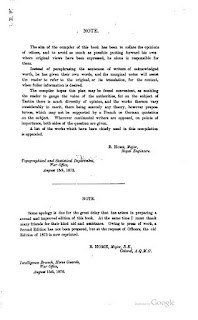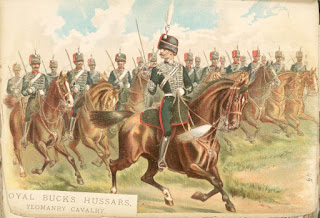This is an ambitious and highly useful reference. The conceit of the book, which you can read for yourself in the below "Note," is to present what "writers of worth" on military topics of the day had to say on an exhaustive range of topics. In other words, Colonel Home has read and translated Jomini (and lots of others) so you (and his readers) don't have to. I reckon that it would take one of those bookish Engineers to undertake such an endeavor--hardly the work of a cavalryman.
The preface (below) outlines in more detail the idea of the book, which was to provide a wide range of information to equip officers not only for examinations but to also to give them an understanding of larger formations of multiple arms that they would need to manage as they gained in seniority (sounds like something wargamers could use, too, no?).
Conflicted Cavarlymen: You can see the writers struggle on the still-vexed topic of how to handle cavalry. The tension, even in the 1892 version, remains between maintaining massed cavalry for combat action and dispersing mounted forces for reconnaissance. Interestingly, there is no mention of or lessons taken from U.S. Civil War cavalry employment (then again, there are few, if any, mentions of the U.S. Civil War at all in the book). Interestingly enough, the writers refer to the Napoleonic Wars for examples of successful combat cavalry employment--another insight into the traditional-mindedness of the day. At the end of the day, there is still the dominant idea that there will be a time and a place on the battlefield for traditional cavalry shock action by large bodies of horse.
The experts emphasize that lateral maneuver was impossible in the face of enemy fire. This is an interesting point that I had never heard stated so explicitly before, and certainly makes one think about how our units tend to dance about on the table in front of the enemy. It does fit in with other statements (made repeatedly in the Napoleonic context) about the difficulty of controlling soldiers, especially dispersed ones, once in contact with the enemy.
The effect of long range fire is described as basically inconsequential, making one rethink the whole idea of "how long is long?" when imagining the effectiveness of longer ranged small arms vs the Needle Gun, for instance.
The effectiveness of moving fire was also described as low. This is another interesting thing to think about when imagining units combining movement and fire on the table.
There is much discussion about the "thickness" of the "skirmish" line in advance of the main body. Like the conflicted cavalry discussion, there is tension between keeping the skirmish line dispersed to lower casualties but also making it "thick" enough to generate effective fire (especially on the move). At some point, it seems that the term, "skirmish" line isn't what we're talking about any more, but more like the "firing" line.
Artillery Handling: One very interesting point comes across about artillery. It holds its own place in the line, and is only "supported" by infantry (maybe) as in infantry that is deployed to its flanks. As such, the handling of guns is discussed as an independent arm, with an inherent contradiction between its supporting role and its direct action role. This is, of course, before indirect fire, so the guns must be in the line. Although there is discussion about keeping the guns far enough away to not suffer from small arms, there is also discussion about there being a point when the guns must be handled aggressively and pushed forward: another tension in the tactics. There is no mention, interestingly, of the mitrailleuse.
Smokeless Powder: Very much like another eBook that I had mentioned from this period, the writers in this book speculate on the impact of smokeless powder on operations. Nobody really knew what it would mean. I found these passages interesting not so much for what they said about smokeless powder, but for the assumptions that they revealed about the battlefield up until then. For instance, with smokeless powder, artillery could be employed in depth rather than in breadth, which indicates that it was a given that you employed artillery in linear fashion given the obscuration that it generated. Another point was how the attacker, especially cavalry,had always used the obscuration in the wake of a volley as cover to close the distance to contact, meaning that there was a definite calculation going on between the timing of volleys and charges (on both sides). Reminds me of the Kipling line about the Fuzzy Wuzzies "rising up out of the smoke" and crumpling the square.
Well, time for me to start up the grill and do the man-thing for dinner this evening, so I'll leave off at this point. Thanks for checking in and I recommend this reference for all who are interested in post-Napoleonic, pre-Khaki Continental Wars.
Excelsior!



















Fascinating look into this old tome, Ed. Your boiling it down leaving its essence is much appreciated. Never occurred to me that smokeless powder would allow artillery deployment in depth whereas before it had to stick to a linear deployment.
ReplyDeleteImpossible to move laterally in face of rifled muskets? I need to give this one a good think.
As for your included illustrations, the gun and crew seem to be Danish. Is that correct? Without looking at the caption, the crew looked very much like Sardinian artillerymen from 1859.
Great stuff and much appreciated!
Thanks, Jonathan, The book has so much that it is almost impossible to summarize.
DeleteGood eye on the gun crew: close but not quite. Although Scandinavian, the artillerists are actually Swedish. Interesting observation on the Sardinians--I find many correspondences between the uniforms of the Italian States and others in Europe.
Interesting thoughts on the rifle armed infantry, skirmish lines and firing lines. A discussion that needs more conversation than here. I was thinking about the commission work I have Steve undertaking and I will look to Steve to expand the number of miniatures I have considered as skirmishers.
ReplyDeleteThanks Ed for your post.
Kind regards,
GH
Thanks, GH. In my next post I'll have a bit more news about some things that are in the works with Steve.
Delete